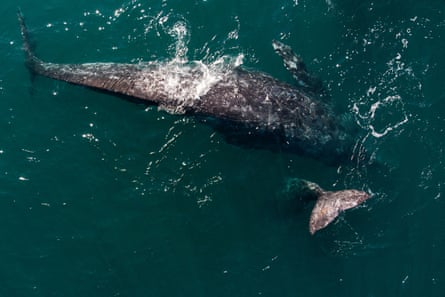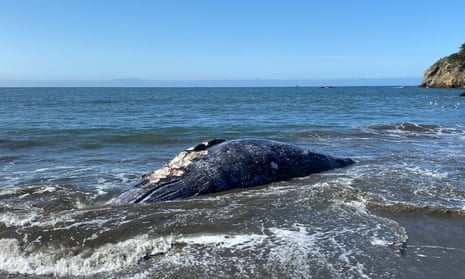Four dead gray whales have washed up on beaches in the San Francisco Bay area in the past nine days, in the latest spate of whale deaths in the region.
One whale died after being struck by a ship, authorities confirmed, with investigations under way into the other mortalities.
The carcass of a 41ft adult female gray whale landed at San Francisco’s Crissy Field on 31 March. A second adult female was found last Saturday in Moss Beach in San Mateo county. A third was found on Wednesday floating near the Berkeley Marina and the following day one washed up in Marin county’s Muir Beach.
A necropsy of the whale at Muir Beach revealed significant bruising and hemorrhaging to muscle around the jaw and neck vertebrae consistent with blunt force trauma due to ship strike. Experts noted the whale was in good body condition based on the blubber layer and internal fat levels. It is still uncertain how the other three whales died, or if starvation was behind their deaths.
“It’s alarming to respond to four dead gray whales in just over a week because it really puts into perspective the current challenges faced by this species,” said Dr Pádraig Duignan, director of pathology at the Marine Mammal Center (MMC).
In 2019, the MMC was involved in looking into why 13 dead whales washed up ion the Bay Area. The National Park Service reported the year previously that a “large number” of dead whales were being found.
Whales are threatened by a variety of human interventions, including entanglement in fishing gear and ship strikes. The climate crisis is heating up and acidifying the ocean, altering the availability of prey.
Biologists have reported several recent cases of malnutrition in gray whales in the region. Nearly one in four gray whales migrating along the US west coast have died since the last recorded population surveys in 2015 and 2016, according to the National Ocean and Atmospheric Administration (Noaa). The MMC said losses could be even greater due to the limited boat and aerial surveys taken during the Covid-19 pandemic.

Each winter, the whales migrate 10,000 miles to Mexican waters, where they mate and birth calves near the coast of Baja California. They head back north and stay off the coast of California in spring and summer to feed on anchovies, sardines and krill before continuing on their northerly migration to cool, food-rich Arctic waters.
“This many dead whales in a week is shocking, especially because these animals are the tip of the iceberg,” said Kristen Monsell, legal director of the Center for Biological Diversity’s oceans program. Experts estimate the washed-up whales represent just 10% of the total dead, with the rest sinking into the sea unnoticed by humans.
Monsell said California lawmakers needed to require fishing gear that does not use rope and federal regulators should set mandatory speed limits for ships.
“Ship strikes and fishing gear entanglements kill many whales that we never see,” she said.
